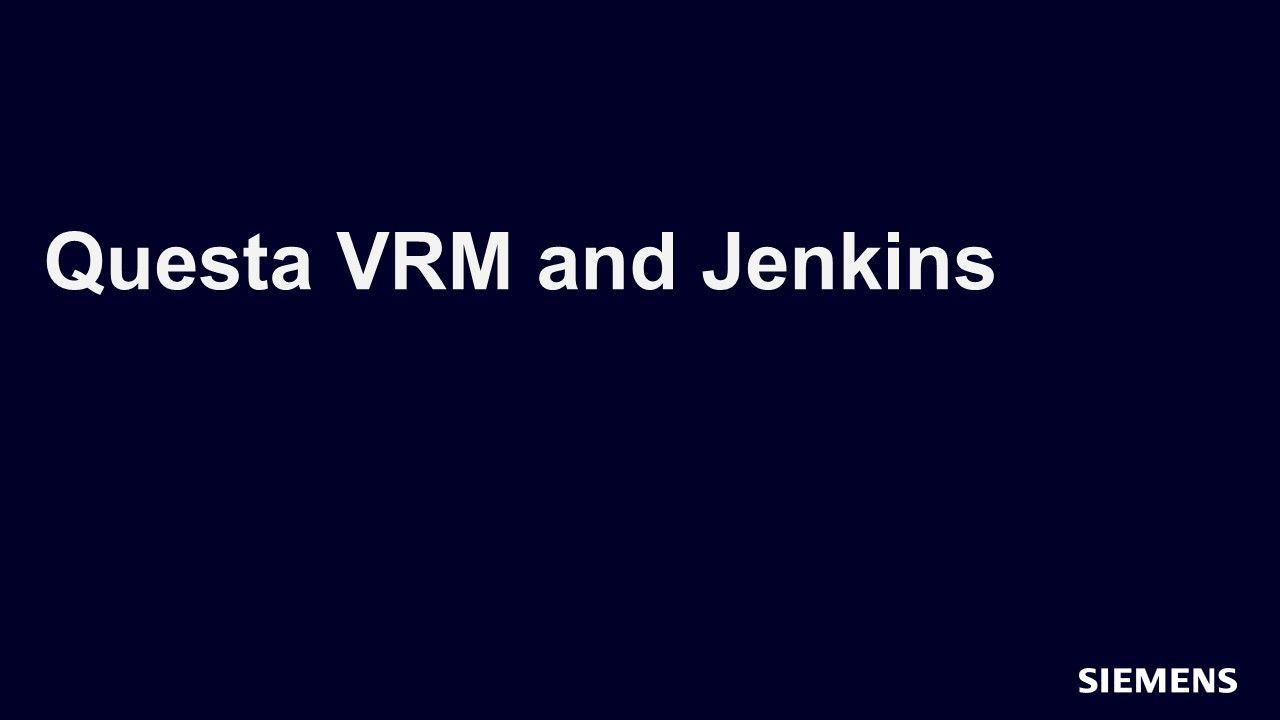Verification Management
Verification is an essential step in the design and development process of complex systems, ensuring that the final product meets the specified requirements and functions as intended. With the increasing complexity of modern systems, the role of verification engineers has become more critical than ever.
To streamline and optimize the verification process, verification management techniques have emerged as a valuable approach. In this article, we will explore what verification management is and how verification engineers can leverage this technique to enhance their efficiency and effectiveness.
-
Verification Management Tracks
-

Questa VRM and Jenkins
This track will define terms, logically divide up the verification effort, and lay the foundation for actual verification planning and management on a real project. -

Verification Planning and Management
This track will define terms, logically divide up the verification effort, and lay the foundation for actual verification planning and management on a real project.
-
-
Verification Management Discussion
-
Block Container: Verification Management Introduction
-
Understanding Verification Management
Verification management is a comprehensive discipline that integrates a range of methodologies, tools, and best practices to streamline the planning, execution, and monitoring of the verification process. Its primary objective is to establish a structured framework, enabling verification engineers to methodically validate and confirm system designs, while simultaneously optimizing productivity and mitigating errors.
At its core, verification management encompasses diverse dimensions, encompassing requirements management, test planning, testbench development, test execution, coverage analysis, bug tracking, and reporting. By harmonizing these facets, it endeavors to establish a well-structured, efficient, and quality-driven verification process.
One essential component of verification management is requirements management. It involves systematically capturing, documenting, and organizing the functional and performance requirements of the system design. This ensures that the verification process aligns with the intended objectives, minimizing ambiguity and ensuring comprehensive coverage.
Test planning is another critical aspect of verification management. It entails developing a comprehensive strategy to validate the system design. This includes defining test objectives, identifying critical areas for verification, and establishing test goals and milestones. By carefully planning the verification process, engineers can optimize resource allocation and prioritize efforts effectively.
Testbench development is an integral part of verification management. It entails designing and implementing the environment in which the system design will be tested. A well-structured and efficient testbench facilitates thorough testing, encompassing stimuli generation, coverage collection, and monitoring of the design under test.
Test execution is the phase in which the actual verification process takes place. Verification management focuses on ensuring that the test execution is systematic, controlled, and comprehensive. It involves running test cases, capturing results, and verifying the system behavior against the expected outcomes.
Coverage analysis is another crucial element of verification management. It involves assessing the completeness and effectiveness of the verification process. By analyzing coverage metrics, engineers can evaluate the extent to which the design has been exercised and identify areas that require further testing, enhancing the overall quality of the verification effort.
Bug tracking is an essential activity within verification management. It involves identifying, documenting, and managing defects or issues encountered during the verification process. Tracking bugs facilitates their resolution, ensuring that the design meets the required specifications and improving overall product quality.
Reporting plays a significant role in verification management. It involves generating comprehensive and informative reports, summarizing the verification progress, results, and findings. These reports provide stakeholders with a clear understanding of the verification status and enable informed decision-making throughout the project lifecycle.
-
-
Block Container: Verification Management Bullets
-
Verification Management Advantages
Improved Planning and Organization
Verification management techniques enable verification engineers to establish a well-defined verification plan, breaking down the verification tasks into manageable units. This helps in identifying dependencies, estimating effort, and allocating resources effectively. By having a clear roadmap, engineers can prioritize tasks, set realistic goals, and ensure efficient use of time and resources.
Enhanced Testbench Development
A critical aspect of verification management is the development of a robust testbench environment. Verification engineers can leverage this technique to build reusable and scalable testbenches, incorporating advanced verification methodologies such as constrained-random stimulus generation, functional coverage, and assertion-based verification. By adopting standardized methodologies, engineers can save time and effort while improving the effectiveness of the verification process.
Efficient Test Execution
Verification management emphasizes the importance of efficient test execution. Verification engineers can leverage techniques such as regression testing, test automation, and parallel execution to speed up the verification process. These approaches enable engineers to validate system designs more quickly, detect bugs early on, and reduce the overall verification cycle time.
Comprehensive Coverage Analysis
Verification management techniques provide verification engineers with robust coverage analysis capabilities. By tracking coverage metrics such as code coverage, functional coverage, and assertion coverage, engineers can assess the completeness and quality of the verification process. This enables them to identify areas of the design that require additional testing and make informed decisions to improve overall verification effectiveness.
-
Verification Management Advantages - Column B
Streamlined Bug Tracking and Reporting
Verification management emphasizes the importance of effective bug tracking and reporting. Verification engineers can utilize dedicated bug tracking tools to capture, prioritize, and track the status of identified issues. This allows for better collaboration among team members, reduces duplicate efforts, and ensures that bugs are addressed promptly. Furthermore, comprehensive reporting capabilities enable engineers to communicate the progress and results of the verification process to stakeholders effectively.
Integration with Design Process
Verification management techniques facilitate close integration between the design and verification processes. By establishing clear communication channels and feedback loops, verification engineers can collaborate with designers to address issues and refine the design iteratively. This integration ensures that verification efforts align with design goals, resulting in a more efficient and effective verification process.
Continuous Improvement and Learning
Verification management encourages a culture of continuous improvement and learning among verification engineers. By leveraging historical data, metrics, and lessons learned, engineers can identify areas for improvement and refine their verification methodologies. This iterative approach helps in enhancing the overall efficiency, effectiveness, and quality of the verification process over time.
-
-
Block Container: Verification Management Conclusion
-
Verification Management Conclusion
In summary, verification management encompasses a wide range of strategies and practices that empower verification engineers to streamline and optimize the verification process. Through the application of diverse techniques, these engineers can improve their planning, testbench development, test execution, coverage analysis, bug tracking, and reporting.
Verification management is a complex and interdisciplinary field that brings together methodologies, tools, and best practices to establish a structured, efficient, and high-quality verification process. By adopting this comprehensive approach, engineers can ensure that the system design verification is conducted effectively and reliably.
One key aspect of verification management is requirements management, which involves understanding and documenting the functional and performance requirements of the system under verification. By carefully managing these requirements, engineers can align their efforts with the intended goals and objectives of the design.
Another crucial element is test planning, where engineers strategically determine the scope and coverage of their verification efforts. This process involves identifying critical scenarios, defining test objectives, and developing test plans that comprehensively exercise the system's functionality.
Testbench development is an essential step in the verification process, as it involves creating a set of testbench components that stimulate the design and provide stimuli for the tests. Through careful construction and integration of these components, engineers can accurately mimic real-world scenarios and ensure thorough testing.
During test execution, engineers execute the testcases on the design and observe its behavior. By meticulously monitoring and analyzing the results, they can identify any deviations or bugs, which are then tracked and managed through bug tracking systems. This allows for effective issue resolution and continuous improvement of the design.
Coverage analysis is another critical aspect of verification management, as it involves assessing the completeness of the test suite by measuring the extent to which different aspects of the design have been exercised. Through comprehensive coverage analysis, engineers can identify areas that require additional testing and achieve a higher level of confidence in the design's correctness.
Finally, verification management emphasizes the importance of reporting. Through regular reporting, engineers provide stakeholders with insights into the verification progress, including the status of test execution, coverage metrics, and bug tracking statistics. This transparent and communicative approach fosters collaboration and ensures that all stakeholders are informed about the verification process.
In conclusion, verification management is a multifaceted discipline that harmonizes various methodologies, tools, and best practices to ensure a structured, efficient, and high-quality verification process. By addressing aspects such as requirements management, test planning, testbench development, test execution, coverage analysis, bug tracking, and reporting, verification management enhances the effectiveness and reliability of system design verification.
-